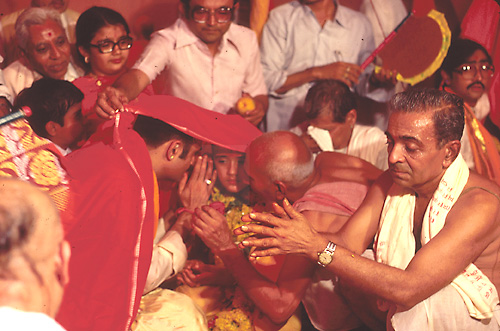
“As a member of that community, with a place in the web of history,
he would now be able to learn from anybody and everybody.”
Photo by Raymond Williams
"Life is a relay race of generations. It requires that things be
passed, at times rather desperately, from one generation to the next.
At the least, it is the transfer of a tool, a skill, a craft; at its grandest
and most dangerous because most vulnerable, it is a way of seeing the
world—a world that goes on and on, seen from a life that is once
and only.”
Magazine
Winter/Spring 2002

The Sacred Thread
Professor Raymond Williams H’68 is talking about the lotus—the
national symbol of India.
“Its petals are beautiful, but it emerges from the mirkiest, dirtiest
water there is. The lotus transforms that.
“People who visit India either become enamored of the flower, or
repulsed by the water. I became intrigued by the beauty, the color, the
pageantry, and the lovely people—so generous, so hospitable.”
That hospitality, Williams’ scholarly work—and a budding friendship
with the Hindu acharya [esteemed religious teacher] Tejendraprasad (Tej)
Pande— brought the professor to a singularly auspicious occasion
in the life of the Swaminarayan Hindu sect he’s studied for almost
three decades. In 1981, he was an honored guest at the sacred thread ceremony
for the acharya’s seven-year-old son, Koshalendraprasad (Kosh). Celebrated
on the 200th anniversary of the birth date of the sect’s founder,
the rite would mark Kosh’s initiation as a religious student, a stage
through which every Brahmin son must pass. But this was the initiation
of an acharya’s son and, as the professor recalls, thousands thronged
to the temple at Amdavad to participate:
It was clearly a momentous event for the whole community. I passed through
a huge crowd to enter the gates and into the courtyard of the haveli,
which was surrounded by four stories of balconies, each packed with onlookers.
A slice of light from a slit in the roof covering slanted from the ceiling
to the floor. It was hot—well over 100 degrees—and the ceremony
was already in progress.
Kosh sat on the covered floor with his father, surrounded by other religious
specialists and family members. A strand of thread stretched from Kosh
to a canvas screen, behind which his mother sat. As the wife of the archarya,
she is never seen in public by anyone except family members, but she is
a religious specialist in her own right.
Sacrifices were offered in a sacred fire, with celebrants instructed when
to toss grains, oil, or ghee, into the flames. Kosh and his two cousins,
also being initiated, were bathed, still wearing their undergarments,
after their heads were shaved.
Then Kosh was dressed in the clothing of a wandering student. Much of
the symbolism of the ceremony reflected his entrance into the study of
sacred texts. Before modern times, a brachmachari [student] was expected
to leave home and wander the countryside, learning from wise men in temples
and ashrams. Like most modern brahmachari, Kosh would be learning at home
and in a local school. (In a pre-planned part of the ritual, his uncle
convinces him to stay!) But, as is the tradition, he was handed a staff
for his journey and sacred books for study.
During the more than three-hour ritual there was plenty of noise, plenty
of coming and going. But there came a time when things became very quiet.
Tej had placed the sacred thread on Kosh’s shoulder. Then, as a cloth
was held over Kosh and his father, Tej leaned forward, raised his hands
to his lips, and whispered the Swaminaryan mantra into his son’s
ear.
The ceremony continued. Well-wishers came forward with gifts of clothing
and food.
But the transformation was complete. By whispering the mantra and performing
the initiation, Tej had “opened the book” for Kosh— he
set his son on a path to seek wisdom not only from his family and sacred
scriptures, but from other teachers, as well. As a member of that community,
with a place in the web of history, he would now be able to learn from
anybody and everybody. In fact, he went on to study at St. Xavier School
and St. Xavier College in Amdavad, from which his father had graduated.
Wabash biologist Robert Petty once noted that “[life is] a relay
race of generations. It requires that things, which in themselves are
insignificant, be passed, at times rather desperately, from one generation
to the next. At the least, it is the transfer of a tool, a skill, a craft;
at its grandest and most dangerous because most vulnerable, it is a way
of seeing the world—a world that goes on and on, seen from a life
that is once and only.”
The sacred thread ceremony is a life-changing moment for a Brahmin boy.
Yet I see it as a metaphor for both the fact that learning takes place
in a community and that the community values, sustains, and mines the
wealth of tradition, which enables the community to grow in wisdom. It
illumines for me our work in the College. Like the newly initiated brahmachari,
the student arriving at a liberal arts college becomes a member of just
such a community, where the faculty preserves what is past, refines and
works it, and uses the past as a way of pushing towards the future.
Whether it takes place in a religious community or at a liberal arts college,
the “opening of the book” is a beautiful thing.
Edited and excerpted from an interview with Raymond Williams, Wabash
religion professor, author of An Introduction to Swaminarayan Hinduism,
and director of the Wabash Center for Teaching and Learning in Theology
and Religion.
Return to the table of contents
